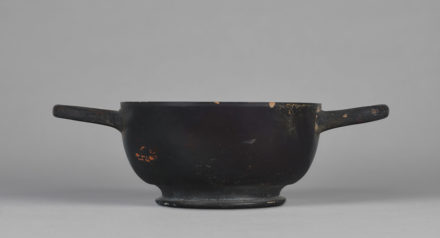
Renée Ater at the Getty Center in December 2018. Dr. Ater was a scholar at the Getty Research Institute during the 2018/2019 scholar year, which focuses on the theme of MONUMENTALITY. Photo: Tristan Bravinder
Scholar James Young once posed this provocative question: How does a nation memorialize a past it might rather forget? Art historian Renée Ater is exploring this question by researching 25 monuments to the slave past located in the South, Midwest, and Northeast of the United States.
A 2018 Getty Scholar and an associate professor emerita of the history of art at the University of Maryland, College Park, Ater plans to publish her findings in a forthcoming digital project, Contemporary Monuments to the Slave Past: Race, Memorialization, and Civic Engagement.
Contraband and Freedmen Cemetery Memorial
A key site included in Ater’s digital project is the Contraband and Freedmen Cemetery Memorial in Alexandria, Virginia, which features the monumental statue Path of Thorns and Roses by Mario Chiodo, a California-based artist. The site is emblematic of challenges inherent in creating memorials to slavery.

Path of Thorns and Roses, dedicated 2014, Mario Chiodo. Bronze. Photo: Renée Ater. With permission from the City of Alexandria
Ater lives in Washington, DC, and remembers friends telling her 15 years ago that there was a cemetery located on the drive on Route 1 south into Virginia. “I would drive by and had no idea what they were talking about because I could only see a gas station,” she recalls.
Ater later learned that the site was a cemetery for enslaved people who had followed the Union Army during the American Civil War on their own free will to escape the bondage of slavery. Men, women, and children seeking freedom arrived penniless and malnourished to Alexandria, located on the border of the Union and the Confederacy.
The Union Army referred to them as “contrabands of war” because the army used them as laborers to build roads, do laundry, and cook. The newly emancipated were housed in cramped quarters where diseases such as typhoid and scarlet fever quickly spread. Many did not survive, and more than 1,800 were buried at the Contraband and Freedmen Cemetery Memorial, which was founded in 1864.
By the end of the nineteenth century, however, the cemetery had disappeared from maps of Alexandria, and by the 1950s it had been paved over. A gas station was built on the site in 1955, followed by an office building in 1960. Rediscovered in the 1980s, the cemetery became a focus of interest, and archaeological excavations began in 1999.
Louise Massoud and Lillie Finklea founded the Friends of Freedmen’s Cemetery in 1996 and worked relentlessly over a decade to make sure that the cemetery didn’t disappear. Their persistence paid off. The City of Alexandria purchased the office building and gas station, tore them down in 2007, and began plans to create a public memorial in 2008.
Today the memorial park includes contemporary gravestones of the unidentified African American formerly enslaved and freed persons, an open structure called The Place of Remembrance, and the statue Path of Thorns and Roses.

Aerial view of the Contraband and Freedmen Cemetery after removal of gas station, ca. 2007, Alexandria, Virginia. Image courtesy of and © Virginia Department of Historic Resources
Ater’s First Visit to the Cemetery
When Ater and her husband first visited the Contraband and Freedmen Cemetery in 2017, they were overwhelmed by the notion that people had deliberately destroyed the cemetery. “I was appalled by the actions of the gas station owners,” says Ater. “The minute they started to excavate, to put those gas tanks in there, they must have encountered bodies and proceeded anyway.”

Grave marker at the Contraband and Freedmen Cemetery. Photo: Renée Ater
The site is on a bluff that overlooks the freeway, and Ater recalls walking up a slight incline to the cemetery as the sun began to set. “There’s a forward momentum to visiting the site,” she says, “even as you reflect on the lost lives and folks following the Union Army to a kind of freedom, and then imagine them arriving in Alexandria and facing illness and shortages of food, clothing, and shelter.”
As she and her husband continued to walk up the slope, the sculpture Path of Thorns and Roses increased in size until they stood before the statue, dwarfed, she recalls, “by its looming form of writhing and gesturing black bodies in bronze.”
Depicting the Enslaved Body
Mario Chiodo’s sculpture Path of Thorns and Roses offers a transcendent narrative of hope, says Ater, but also reveals the difficulties artists face in visualizing the historical enslaved body for a public space. For Ater, the statue is a “mash-up” featuring nineteenth-century forms and a stereotypical unclothed body. “I have brought several people there, and they have huge problems with the unclothed black body,” she says.

“Oppression” from Path of Thorns and Roses (detail), dedicated 2014, Mario Chiodo. Bronze. Photo: Renée Ater. With permission from the City of Alexandria
Ater questions whether it is truly possible to visualize the trauma of slavery. “What does black suffering look like from the slave past?” she asks. “How do you actually manifest that in three-dimensional form? How do you model it in clay? How do you cast it? How do we manifest that trauma, that suffering, that horror that we really can’t know in the twenty-first century? We can’t know what it would be like to be lashed 50 times for violating some kind of code on a plantation. We can’t know what it would have been like to come to Alexandria as a formerly enslaved person seeking freedom.”

Front of “Slave Pen,” 1315 Duke Street, Alexandria, Virginia, 1861–65, Andrew J. Russell, photographer. Sign reads “Price, Birch & Co, Dealers in Slaves.” Library of Congress, LOT 11486-H, no. 10

Slave House of J. W. Neal & Co. from Slave Market of America (detail), 1826, American Anti-Slavery Society. Library of Congress, Broadside Collection, portfolio 118, no. 26 c-Rare Bk Coll

Fugitive African Americans Fording the Rappahannock River, Rappahannock, Virginia, ca. 1862, Timothy H. O’Sullivan. Library of Congress, LC-B815-518
Chiodo’s sculpture features six figures representing Oppression, Struggle, Loss, Sacrifice, Compassion, and Hope. Ater believes that the sculpture’s legibility—what we see or understand to be happening in the Path of Thorns and Roses—might be difficult for the common observer to grasp. “The allegorical forms are not labeled on the monument,” she notes. “I have an art history background, so I know it ends up in Hope. I know that the artist talks about it in that way, but I wonder just how legible the forms are to visitors.”

“Hope” from Path of Thorns and Roses (detail), dedicated 2014, Mario Chiodo. Bronze. Photo: Renée Ater. With permission from the City of Alexandria
As Ater puzzled over the position of Oppression at the bottom of the sculpture and Hope at the top, she was troubled by the idea that hope arises from oppression. But after reading Gëzim Qëndro’s essay “The Thanatology of Hope,” about the Martyrs’ Cemeteries of the National Liberation War in Albania, she saw that death and hope can coexist in the same place or object.
A Place of Reconciliation

A quotation from Harriet Jacobs appears at the base of Path of Thorns and Roses, dedicated 2014. Photo: Renée Ater. With permission from the City of Alexandria
To heal the issue of the slave past in the United States, Ater notes, we must figure out how to have a public conversation about what slavery means to our community—“even if it’s hard, even if it’s an ugly conversation.”
For Ater the cemetery is a place of reconciliation: It enables residents of Alexandria to acknowledge the slave past and what needs to be done today to improve life in their community, and it gives family members of formerly enslaved people a place to discover ancestors they did not know. “That lineage, that connection to the past is important to all of us,” she says.
To further this connection, Ater plans to create a scholarly, interpretive project on the Contraband and Freedmen Cemetery and other monuments to the slave past that takes advantage of the digital realm. “I could not figure out how to do a monument project in a two-dimensional book,” she says. “I want audio, video, photogrammetry, three-dimensional models of some monuments, photographs, and artist interviews.” An example of her digital project is her work on memorials to Harriet Tubman, using interactive maps and timelines.
To learn more about Ater’s project and work, see her website (which includes a recent storymap of Harriet Tubman memorials). To further explore the site and history of the Contraband and Freedman Cemetery, see this photo gallery from the City of Alexandria.




Comments on this post are now closed.